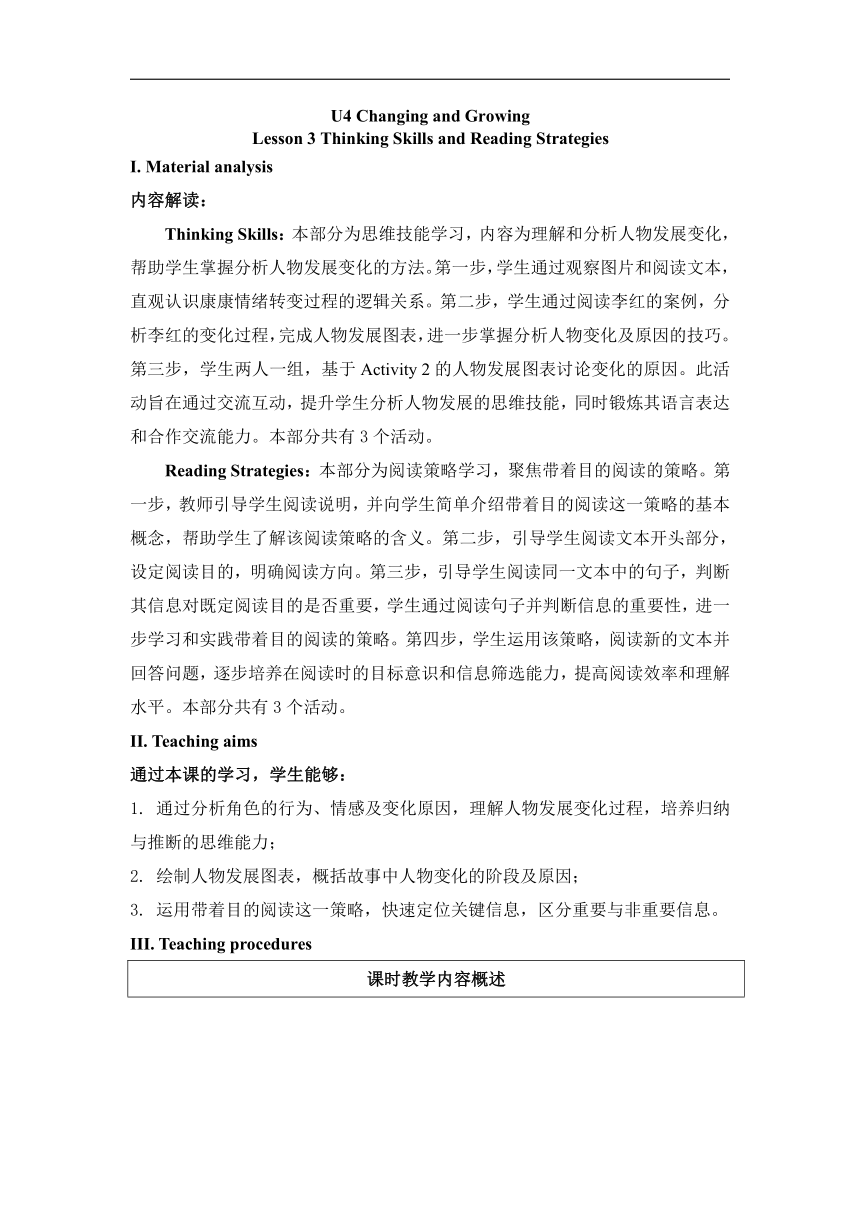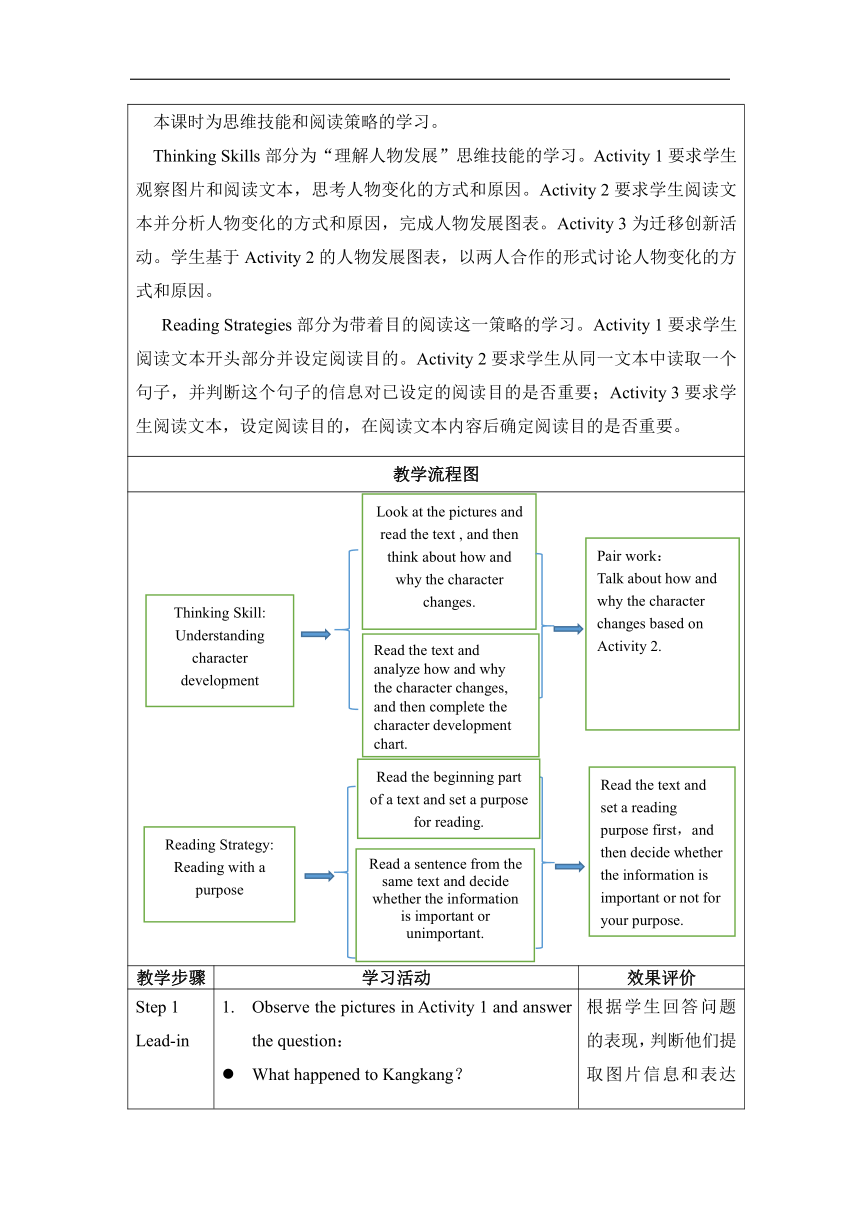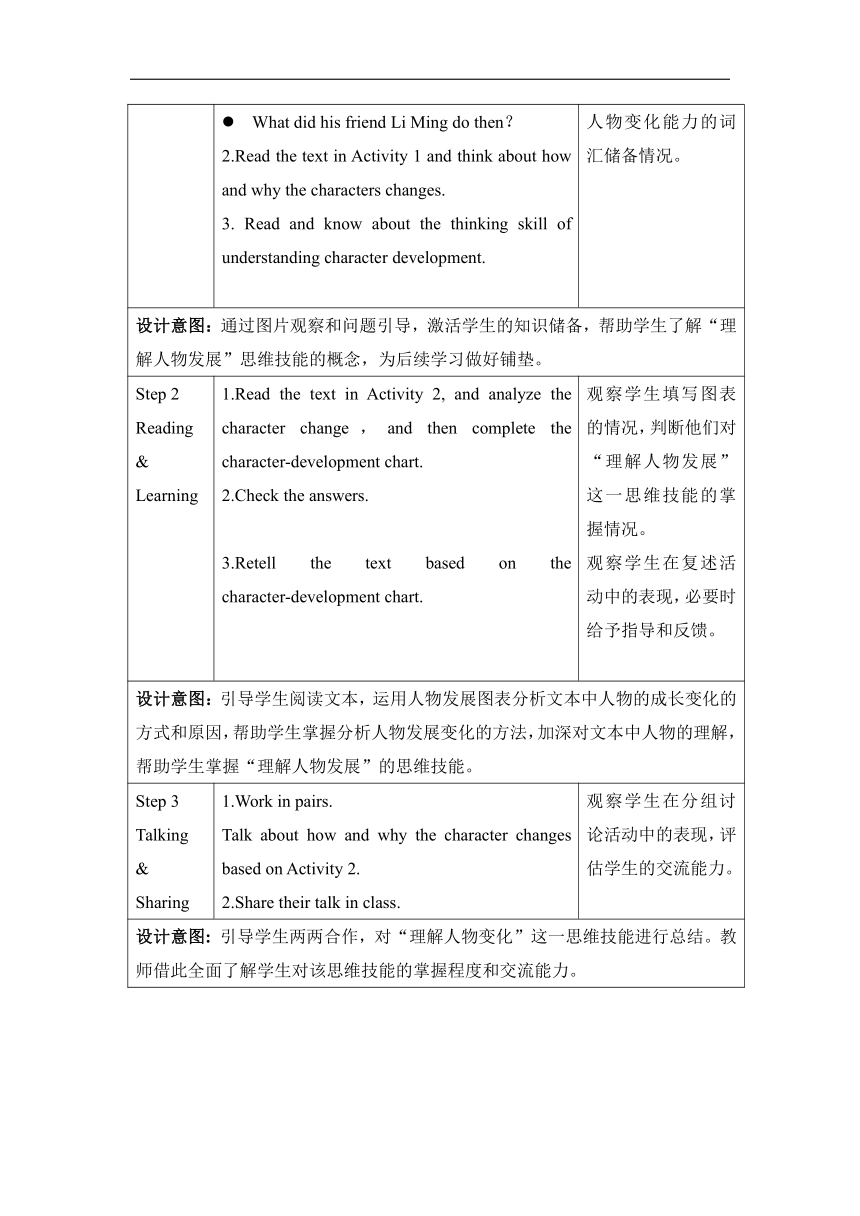Unit4 Lesson3 Thinking Skills and Reading Strategies教学设计(表格式)2025-2026学年仁爱科普版(2024)八年级英语上册
文档属性
| 名称 | Unit4 Lesson3 Thinking Skills and Reading Strategies教学设计(表格式)2025-2026学年仁爱科普版(2024)八年级英语上册 |

|
|
| 格式 | docx | ||
| 文件大小 | 28.2KB | ||
| 资源类型 | 教案 | ||
| 版本资源 | 仁爱科普版 | ||
| 科目 | 英语 | ||
| 更新时间 | 2025-08-22 21:18:24 | ||
图片预览



文档简介
U4 Changing and Growing
Lesson 3 Thinking Skills and Reading Strategies
I. Material analysis
内容解读:
Thinking Skills:本部分为思维技能学习,内容为理解和分析人物发展变化,帮助学生掌握分析人物发展变化的方法。第一步,学生通过观察图片和阅读文本,直观认识康康情绪转变过程的逻辑关系。第二步,学生通过阅读李红的案例,分析李红的变化过程,完成人物发展图表,进一步掌握分析人物变化及原因的技巧。第三步,学生两人一组,基于Activity 2的人物发展图表讨论变化的原因。此活动旨在通过交流互动,提升学生分析人物发展的思维技能,同时锻炼其语言表达和合作交流能力。本部分共有3个活动。
Reading Strategies:本部分为阅读策略学习,聚焦带着目的阅读的策略。第一步,教师引导学生阅读说明,并向学生简单介绍带着目的阅读这一策略的基本概念,帮助学生了解该阅读策略的含义。第二步,引导学生阅读文本开头部分,设定阅读目的,明确阅读方向。第三步,引导学生阅读同一文本中的句子,判断其信息对既定阅读目的是否重要,学生通过阅读句子并判断信息的重要性,进一步学习和实践带着目的阅读的策略。第四步,学生运用该策略,阅读新的文本并回答问题,逐步培养在阅读时的目标意识和信息筛选能力,提高阅读效率和理解水平。本部分共有3个活动。
II. Teaching aims
通过本课的学习,学生能够:
1. 通过分析角色的行为、情感及变化原因,理解人物发展变化过程,培养归纳与推断的思维能力;
2. 绘制人物发展图表,概括故事中人物变化的阶段及原因;
3. 运用带着目的阅读这一策略,快速定位关键信息,区分重要与非重要信息。
III. Teaching procedures
课时教学内容概述
本课时为思维技能和阅读策略的学习。 Thinking Skills部分为“理解人物发展”思维技能的学习。Activity 1要求学生观察图片和阅读文本,思考人物变化的方式和原因。Activity 2要求学生阅读文本并分析人物变化的方式和原因,完成人物发展图表。Activity 3为迁移创新活动。学生基于Activity 2的人物发展图表,以两人合作的形式讨论人物变化的方式和原因。 Reading Strategies部分为带着目的阅读这一策略的学习。Activity 1要求学生阅读文本开头部分并设定阅读目的。Activity 2要求学生从同一文本中读取一个句子,并判断这个句子的信息对已设定的阅读目的是否重要;Activity 3要求学生阅读文本,设定阅读目的,在阅读文本内容后确定阅读目的是否重要。
教学流程图
(
Look at the pictures and read the text ,
and then t
hink about how and why the character changes
.
) (
Pair work:
Talk about how and why the character changes based on
Activity 2.
) (
Thinking
S
kill:
Understanding character development
) (
Read the text and analyze how and why the character changes
,
and then complete the character development chart
.
) (
Read the beginning part of a text and set a purpose for reading
.
) (
Read the text and set a reading purpose first,
and
then decide
whether
the information is important or not for your purpose
.
) (
Read a sentence
from the same text
and decide whether the information is important or unimportant
.
) (
Reading
S
trategy:
Reading with
a
purpose
)
教学步骤 学习活动 效果评价
Step 1 Lead-in Observe the pictures in Activity 1 and answer the question: What happened to Kangkang? What did his friend Li Ming do then? 2.Read the text in Activity 1 and think about how and why the characters changes. 3. Read and know about the thinking skill of understanding character development. 根据学生回答问题的表现,判断他们提取图片信息和表达人物变化能力的词汇储备情况。
设计意图:通过图片观察和问题引导,激活学生的知识储备,帮助学生了解“理解人物发展”思维技能的概念,为后续学习做好铺垫。
Step 2 Reading & Learning 1.Read the text in Activity 2, and analyze the character change,and then complete the character-development chart. 2.Check the answers. 3.Retell the text based on the character-development chart. 观察学生填写图表的情况,判断他们对“理解人物发展”这一思维技能的掌握情况。 观察学生在复述活动中的表现,必要时给予指导和反馈。
设计意图:引导学生阅读文本,运用人物发展图表分析文本中人物的成长变化的方式和原因,帮助学生掌握分析人物发展变化的方法,加深对文本中人物的理解,帮助学生掌握“理解人物发展”的思维技能。
Step 3 Talking & Sharing 1.Work in pairs. Talk about how and why the character changes based on Activity 2. 2.Share their talk in class. 观察学生在分组讨论活动中的表现,评估学生的交流能力。
设计意图: 引导学生两两合作,对“理解人物变化”这一思维技能进行总结。教师借此全面了解学生对该思维技能的掌握程度和交流能力。
Step 4 Reading strategies 1.Read and understand the strategy of reading with a purpose. 2.Read the beginning part of a text in Activity 1 and set a purpose for reading. Then check the answer. 3.Read a sentence in Activity 2 and decide whether the information is important or unimportant for your reading purpose. Then check the answer. 4.Read the text in Activity 3 and set a reading purpose first, and then decide whether the information is important or unimportant. Then check the answer. 通过观察学生完成表格的状况,评估其对带着目的阅读这一阅读策略的运用能力,判断学生对该项技能的迁移能力,必要时给予指导和反馈。
设计意图: 通过阅读文本,引导学生运用带着目的阅读这一策略来获取文本关键信息,培养学生判断信息重要性的能力和筛选关键信息的能力,提升阅读技巧。
IV. Blackboard design
Unit 4 Changing and Growing Lesson 3 Thinking Skills and Reading Strategies Thinking Skill: Understanding character development Character grow and change in the story. You can understand character development by analyzing how and why a character changes. Reading strategy: Reading with a purpose Set a purpose before reading, you can decide what is important and what is not for reading purpose.
V. Teaching materials
Thinking Skills: Understanding character development
How to understand character development
Exercise 1 Read the text and answer the questions.
Last year, I failed an important math exam. In the beginning, I felt very sad. I studied hard, but I still didn’t do well. I even thought I would never be good at math. I wanted to give up. But my teacher encouraged me. She said failure is a chance to learn. I decided to try again. I made a study plan and practiced every day. I also asked my friends for help. In the end, I took the exam again. This time, I got a good grade. I was happy and confident again.
What happened at first
Did “I” change in the middle If so, why
What happened in the end
Exercise 2 Read the text and draw a character-development chart.
Sam wanted to learn how to ride a bicycle. So, he asked his dad to teach him.
At first, Sam found it really hard. He always fell down. His knees got hurt, and he felt a bit sad. But his dad helped him and said, “You can do it!” Sam kept trying. Each time he fell, he got back on the bike. Slowly, he started to ride a little bit without falling. One sunny afternoon, Sam’s dad let go of the bike, and Sam kept riding all by himself! He was so excited that he rode around the park happily.
Beginning: Sam wanted ____________________, but he _________________.
Middle: His dad _____________________ and Sam _____________________.
End: Sam _______________________________________________________.
Reading Strategies Reading with a purpose
Exercise 1 Reading the text and answer the questions.
Growth brings many changes. When we are young, we are small and need help with many things. As we grow, we get taller and stronger. We learn to do things by ourselves. Our interests also change. We might like toys when we are little, but as we grow, we start to like books, music, or sports. We make new friends and learn new things. Our feelings change too. We might be shy when we are young, but as we grow, we become more confident. We learn to face challenges and solve problems. These changes help us become better people. Growth is a wonderful journey.
What is your reading purpose
Which information is important
We are young.
As we grow, we get taller and stronger.
Growth is a wonderful journey.
Which information is unimportant
Our interests also change.
These changes help us become better people.
Our feelings change too.
How to decide whether the information is important or unimportant
Exercise 2 Reading the text. Set a reading purpose first, and then decide whether the information is important or not.
Growing up brings many questions and problems. This is normal! Here are easy ways to handle them. First, talk to someone you trust. Share your feelings with parents, teachers, or friends. They might have helpful advice or similar experiences. Second, remember mistakes help you learn. Failed tests show what to study more. Don’t fear mistakes. They’re practice for success. Lastly, be kind to yourself. Growing takes time. Celebrate small wins like making a new friend or solving a math problem. You’re doing better than you think!
What is your reading purpose
Talk to someone you trust. Important/Unimportant
Remember mistakes help you learn. Important/Unimportant
Be kind to yourself. Important/Unimportant
Lesson 3 Thinking Skills and Reading Strategies
I. Material analysis
内容解读:
Thinking Skills:本部分为思维技能学习,内容为理解和分析人物发展变化,帮助学生掌握分析人物发展变化的方法。第一步,学生通过观察图片和阅读文本,直观认识康康情绪转变过程的逻辑关系。第二步,学生通过阅读李红的案例,分析李红的变化过程,完成人物发展图表,进一步掌握分析人物变化及原因的技巧。第三步,学生两人一组,基于Activity 2的人物发展图表讨论变化的原因。此活动旨在通过交流互动,提升学生分析人物发展的思维技能,同时锻炼其语言表达和合作交流能力。本部分共有3个活动。
Reading Strategies:本部分为阅读策略学习,聚焦带着目的阅读的策略。第一步,教师引导学生阅读说明,并向学生简单介绍带着目的阅读这一策略的基本概念,帮助学生了解该阅读策略的含义。第二步,引导学生阅读文本开头部分,设定阅读目的,明确阅读方向。第三步,引导学生阅读同一文本中的句子,判断其信息对既定阅读目的是否重要,学生通过阅读句子并判断信息的重要性,进一步学习和实践带着目的阅读的策略。第四步,学生运用该策略,阅读新的文本并回答问题,逐步培养在阅读时的目标意识和信息筛选能力,提高阅读效率和理解水平。本部分共有3个活动。
II. Teaching aims
通过本课的学习,学生能够:
1. 通过分析角色的行为、情感及变化原因,理解人物发展变化过程,培养归纳与推断的思维能力;
2. 绘制人物发展图表,概括故事中人物变化的阶段及原因;
3. 运用带着目的阅读这一策略,快速定位关键信息,区分重要与非重要信息。
III. Teaching procedures
课时教学内容概述
本课时为思维技能和阅读策略的学习。 Thinking Skills部分为“理解人物发展”思维技能的学习。Activity 1要求学生观察图片和阅读文本,思考人物变化的方式和原因。Activity 2要求学生阅读文本并分析人物变化的方式和原因,完成人物发展图表。Activity 3为迁移创新活动。学生基于Activity 2的人物发展图表,以两人合作的形式讨论人物变化的方式和原因。 Reading Strategies部分为带着目的阅读这一策略的学习。Activity 1要求学生阅读文本开头部分并设定阅读目的。Activity 2要求学生从同一文本中读取一个句子,并判断这个句子的信息对已设定的阅读目的是否重要;Activity 3要求学生阅读文本,设定阅读目的,在阅读文本内容后确定阅读目的是否重要。
教学流程图
(
Look at the pictures and read the text ,
and then t
hink about how and why the character changes
.
) (
Pair work:
Talk about how and why the character changes based on
Activity 2.
) (
Thinking
S
kill:
Understanding character development
) (
Read the text and analyze how and why the character changes
,
and then complete the character development chart
.
) (
Read the beginning part of a text and set a purpose for reading
.
) (
Read the text and set a reading purpose first,
and
then decide
whether
the information is important or not for your purpose
.
) (
Read a sentence
from the same text
and decide whether the information is important or unimportant
.
) (
Reading
S
trategy:
Reading with
a
purpose
)
教学步骤 学习活动 效果评价
Step 1 Lead-in Observe the pictures in Activity 1 and answer the question: What happened to Kangkang? What did his friend Li Ming do then? 2.Read the text in Activity 1 and think about how and why the characters changes. 3. Read and know about the thinking skill of understanding character development. 根据学生回答问题的表现,判断他们提取图片信息和表达人物变化能力的词汇储备情况。
设计意图:通过图片观察和问题引导,激活学生的知识储备,帮助学生了解“理解人物发展”思维技能的概念,为后续学习做好铺垫。
Step 2 Reading & Learning 1.Read the text in Activity 2, and analyze the character change,and then complete the character-development chart. 2.Check the answers. 3.Retell the text based on the character-development chart. 观察学生填写图表的情况,判断他们对“理解人物发展”这一思维技能的掌握情况。 观察学生在复述活动中的表现,必要时给予指导和反馈。
设计意图:引导学生阅读文本,运用人物发展图表分析文本中人物的成长变化的方式和原因,帮助学生掌握分析人物发展变化的方法,加深对文本中人物的理解,帮助学生掌握“理解人物发展”的思维技能。
Step 3 Talking & Sharing 1.Work in pairs. Talk about how and why the character changes based on Activity 2. 2.Share their talk in class. 观察学生在分组讨论活动中的表现,评估学生的交流能力。
设计意图: 引导学生两两合作,对“理解人物变化”这一思维技能进行总结。教师借此全面了解学生对该思维技能的掌握程度和交流能力。
Step 4 Reading strategies 1.Read and understand the strategy of reading with a purpose. 2.Read the beginning part of a text in Activity 1 and set a purpose for reading. Then check the answer. 3.Read a sentence in Activity 2 and decide whether the information is important or unimportant for your reading purpose. Then check the answer. 4.Read the text in Activity 3 and set a reading purpose first, and then decide whether the information is important or unimportant. Then check the answer. 通过观察学生完成表格的状况,评估其对带着目的阅读这一阅读策略的运用能力,判断学生对该项技能的迁移能力,必要时给予指导和反馈。
设计意图: 通过阅读文本,引导学生运用带着目的阅读这一策略来获取文本关键信息,培养学生判断信息重要性的能力和筛选关键信息的能力,提升阅读技巧。
IV. Blackboard design
Unit 4 Changing and Growing Lesson 3 Thinking Skills and Reading Strategies Thinking Skill: Understanding character development Character grow and change in the story. You can understand character development by analyzing how and why a character changes. Reading strategy: Reading with a purpose Set a purpose before reading, you can decide what is important and what is not for reading purpose.
V. Teaching materials
Thinking Skills: Understanding character development
How to understand character development
Exercise 1 Read the text and answer the questions.
Last year, I failed an important math exam. In the beginning, I felt very sad. I studied hard, but I still didn’t do well. I even thought I would never be good at math. I wanted to give up. But my teacher encouraged me. She said failure is a chance to learn. I decided to try again. I made a study plan and practiced every day. I also asked my friends for help. In the end, I took the exam again. This time, I got a good grade. I was happy and confident again.
What happened at first
Did “I” change in the middle If so, why
What happened in the end
Exercise 2 Read the text and draw a character-development chart.
Sam wanted to learn how to ride a bicycle. So, he asked his dad to teach him.
At first, Sam found it really hard. He always fell down. His knees got hurt, and he felt a bit sad. But his dad helped him and said, “You can do it!” Sam kept trying. Each time he fell, he got back on the bike. Slowly, he started to ride a little bit without falling. One sunny afternoon, Sam’s dad let go of the bike, and Sam kept riding all by himself! He was so excited that he rode around the park happily.
Beginning: Sam wanted ____________________, but he _________________.
Middle: His dad _____________________ and Sam _____________________.
End: Sam _______________________________________________________.
Reading Strategies Reading with a purpose
Exercise 1 Reading the text and answer the questions.
Growth brings many changes. When we are young, we are small and need help with many things. As we grow, we get taller and stronger. We learn to do things by ourselves. Our interests also change. We might like toys when we are little, but as we grow, we start to like books, music, or sports. We make new friends and learn new things. Our feelings change too. We might be shy when we are young, but as we grow, we become more confident. We learn to face challenges and solve problems. These changes help us become better people. Growth is a wonderful journey.
What is your reading purpose
Which information is important
We are young.
As we grow, we get taller and stronger.
Growth is a wonderful journey.
Which information is unimportant
Our interests also change.
These changes help us become better people.
Our feelings change too.
How to decide whether the information is important or unimportant
Exercise 2 Reading the text. Set a reading purpose first, and then decide whether the information is important or not.
Growing up brings many questions and problems. This is normal! Here are easy ways to handle them. First, talk to someone you trust. Share your feelings with parents, teachers, or friends. They might have helpful advice or similar experiences. Second, remember mistakes help you learn. Failed tests show what to study more. Don’t fear mistakes. They’re practice for success. Lastly, be kind to yourself. Growing takes time. Celebrate small wins like making a new friend or solving a math problem. You’re doing better than you think!
What is your reading purpose
Talk to someone you trust. Important/Unimportant
Remember mistakes help you learn. Important/Unimportant
Be kind to yourself. Important/Unimportant
同课章节目录
